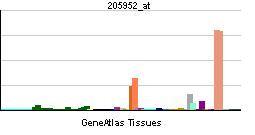KCNK3
| Potassium channel, subfamily K, member 3 | |||||||||||
|---|---|---|---|---|---|---|---|---|---|---|---|
| Identifiers | |||||||||||
| Symbols | KCNK3 ; K2p3.1; OAT1; TASK; TASK-1; TBAK1 | ||||||||||
| External IDs | Template:OMIM5 Template:MGI HomoloGene: 1692 | ||||||||||
| |||||||||||
| RNA expression pattern | |||||||||||
 | |||||||||||
| More reference expression data | |||||||||||
| Orthologs | |||||||||||
| Template:GNF Ortholog box | |||||||||||
| Species | Human | Mouse | |||||||||
| Entrez | n/a | n/a | |||||||||
| Ensembl | n/a | n/a | |||||||||
| UniProt | n/a | n/a | |||||||||
| RefSeq (mRNA) | n/a | n/a | |||||||||
| RefSeq (protein) | n/a | n/a | |||||||||
| Location (UCSC) | n/a | n/a | |||||||||
| PubMed search | n/a | n/a | |||||||||
Potassium channel, subfamily K, member 3, also known as KCNK3, is a human gene.[1]
This gene encodes one of the members of the superfamily of potassium channel proteins containing two pore-forming P domains. The gene product is an outwardly rectifying channel that is sensitive to changes in extracellular pH and is inhibited by extracellular acidification. Also referred to as an acid-sensitive potassium channel, it is activated by the anesthetics halothane and isoflurane. Although three transcripts are detected in northern blots, there is currently no sequence available to confirm transcript variants for this gene.[1]
See also
References
Further reading
- Goldstein SA, Bockenhauer D, O'Kelly I, Zilberberg N (2001). "Potassium leak channels and the KCNK family of two-P-domain subunits". Nat. Rev. Neurosci. 2 (3): 175–84. PMID 11256078.
- Goldstein SA, Bayliss DA, Kim D; et al. (2006). "International Union of Pharmacology. LV. Nomenclature and molecular relationships of two-P potassium channels". Pharmacol. Rev. 57 (4): 527–40. doi:10.1124/pr.57.4.12. PMID 16382106.
- Duprat F, Lesage F, Fink M; et al. (1997). "TASK, a human background K+ channel to sense external pH variations near physiological pH". EMBO J. 16 (17): 5464–71. doi:10.1093/emboj/16.17.5464. PMID 9312005.
- Lesage F, Lazdunski M (1998). "Mapping of human potassium channel genes TREK-1 (KCNK2) and TASK (KCNK3) to chromosomes 1q41 and 2p23". Genomics. 51 (3): 478–9. doi:10.1006/geno.1998.5397. PMID 9721223.
- Patel AJ, Honoré E, Lesage F; et al. (1999). "Inhalational anesthetics activate two-pore-domain background K+ channels". Nat. Neurosci. 2 (5): 422–6. doi:10.1038/8084. PMID 10321245.
- Manjunath NA, Bray-Ward P, Goldstein SA, Gallagher PG (2000). "Assignment of the 2P domain, acid-sensitive potassium channel OAT1 gene KCNK3 to human chromosome bands 2p24.1-->p23.3 and murine 5B by in situ hybridization". Cytogenet. Cell Genet. 86 (3–4): 242–3. PMID 10575216.
- Lopes CM, Gallagher PG, Buck ME; et al. (2000). "Proton block and voltage gating are potassium-dependent in the cardiac leak channel Kcnk3". J. Biol. Chem. 275 (22): 16969–78. doi:10.1074/jbc.M001948200. PMID 10748056.
- Ashmole I, Goodwin PA, Stanfield PR (2002). "TASK-5, a novel member of the tandem pore K+ channel family". Pflugers Arch. 442 (6): 828–33. PMID 11680614.
- Talley EM, Bayliss DA (2002). "Modulation of TASK-1 (Kcnk3) and TASK-3 (Kcnk9) potassium channels: volatile anesthetics and neurotransmitters share a molecular site of action". J. Biol. Chem. 277 (20): 17733–42. doi:10.1074/jbc.M200502200. PMID 11886861.
- Buist SC, Cherrington NJ, Choudhuri S; et al. (2002). "Gender-specific and developmental influences on the expression of rat organic anion transporters". J. Pharmacol. Exp. Ther. 301 (1): 145–51. PMID 11907168.
- Barbuti A, Ishii S, Shimizu T; et al. (2002). "Block of the background K(+) channel TASK-1 contributes to arrhythmogenic effects of platelet-activating factor". Am. J. Physiol. Heart Circ. Physiol. 282 (6): H2024–30. doi:10.1152/ajpheart.00956.2001. PMID 12003807.
- Girard C, Tinel N, Terrenoire C; et al. (2002). "p11, an annexin II subunit, an auxiliary protein associated with the background K+ channel, TASK-1". EMBO J. 21 (17): 4439–48. PMID 12198146.
- O'Kelly I, Butler MH, Zilberberg N, Goldstein SA (2002). "Forward transport. 14-3-3 binding overcomes retention in endoplasmic reticulum by dibasic signals". Cell. 111 (4): 577–88. PMID 12437930.
- Aslamkhan A, Han YH, Walden R; et al. (2003). "Stoichiometry of organic anion/dicarboxylate exchange in membrane vesicles from rat renal cortex and hOAT1-expressing cells". Am. J. Physiol. Renal Physiol. 285 (4): F775–83. doi:10.1152/ajprenal.00140.2003. PMID 12837685.
- Strebel K (2004). "HIV-1 Vpu: putting a channel to the TASK". Mol. Cell. 14 (2): 150–2. PMID 15099514.
- Hsu K, Seharaseyon J, Dong P; et al. (2004). "Mutual functional destruction of HIV-1 Vpu and host TASK-1 channel". Mol. Cell. 14 (2): 259–67. PMID 15099524.
- Rusznák Z, Pocsai K, Kovács I; et al. (2004). "Differential distribution of TASK-1, TASK-2 and TASK-3 immunoreactivities in the rat and human cerebellum". Cell. Mol. Life Sci. 61 (12): 1532–42. doi:10.1007/s00018-004-4082-3. PMID 15197476.
- Bai X, Greenwood SL, Glazier JD; et al. (2005). "Localization of TASK and TREK, two-pore domain K+ channels, in human cytotrophoblast cells". J. Soc. Gynecol. Investig. 12 (2): 77–83. doi:10.1016/j.jsgi.2004.08.004. PMID 15695101.
External links
- KCNK3+protein,+human at the US National Library of Medicine Medical Subject Headings (MeSH)
| Stub icon | This membrane protein–related article is a stub. You can help Wikipedia by expanding it. |
This article incorporates text from the United States National Library of Medicine, which is in the public domain.